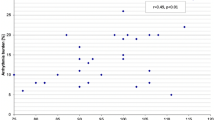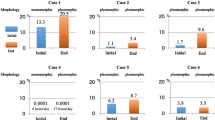Abstract
Background: Isolated monomorphic premature ventricular contractions (PVCs) are not uncommon in the pediatric population. The degree of cardiac dysfunction caused by PVCs in children without structural heart disease is unknown. Purpose: To investigate the influence of PVCs on echocardiographic left ventricular (LV) systolic function in children without structural heart disease. Methods: Forty asymptomatic children with isolated monomorphic PVCs without structural heart disease were selected. The median age was 6 years, range of 3–12 years. The following subgroups were compared: frequent vs. infrequent PVCs (> or ≤10/min); short vs. long coupling interval (RR′/RR ratio ≤ or >0.6); and short vs. long QT interval (QT ≤ or >400 ms). Using echocardiography the left ventricular ejection fraction (LVEF in percentage) and cardiac index (CI in L/min/m2) were measured for both normal sinus beats (SB-LVEF and CI), PVCs (PVC-LVEF and CI) and the average LVEF and CI were calculated. All values were expressed as means ± SD. Results: In all children LV dimensions and the SB-LVEF and CI were within normal limits. The PVC-LVEF (48 ± 5) and PVC-CI (1.57 ± 0.19) were significantly decreased and the average CI was 2.41 ± 0.29. In 27 pts with >10 PVCs/min the average LVEF and CI decreased to 53 ± 5 and 2.08 ± 0.24 respectively. In 16 pts with PVCs and a short coupling interval (RR′/RR ≤ 0.6) the PVC-LVEF and PVC-CI was 43 ± 0.03 and 1.50 ± 0.14, which was significantly lower than in 24 pts with a long coupling interval (58 ± 4, 1.88 ± 0.11). In 11 pts with a prolonged QT interval (>400 ms) the PVC-LVEF and PVC-CI was significantly lower than in the 29 children with a shorter QT interval, 41 ± 5 vs. 55 ± 4 and 1.46 ± 0.13 vs. 1.86 ± 0.15 respectively (all p < 0.01). Conclusion: In asymptomatic children with isolated monomorphic PVCs the average ejection fraction and cardiac output is markedly reduced if PVCs are frequent (>10/min), have a short coupling interval or a prolonged QT interval.
Similar content being viewed by others
References
Yabek SM. Ventricular arrhythmias in children with apparently normal heart. J Ped 1991; 119: 1–11.
Alexander ME, Berul CI. Ventricular arrhythmias: when to worry. Pediatr Cardiol 2000; 21: 532–541.
Facchini M. Increased left ventricular dimensions in patients with frequent nonsustained ventricular arrhythmia and no evidence of underling heart disease. J Cardiovasc Electrophysiol 1999; 10: 1433–1438.
Duffee DF, Shen WK, Smith HC. Suppression of frequent premature ventricular contractions and improvement of left ventricular function in patients with presumed idiopathic dilated cardiomyopathy. Mayo Clin Proc 1998; 73: 430–433.
Chugh SS, Shen WK, Luria DM, Smith HC. First evidence of premature ventricular complex-induced cardiomyopathy: a potentially reversible cause of heart failure. J Cardiovasc Electrophysiol 2000; 11: 328–329.
Eber LM. Dynamic characterization of premature ventricular beats and ventricular tachycardias. Am J Cardiol 1974; 33: 378–383.
Sasayman S. Dynamic changes in left ventricular regional wall thickness during premature ventricular contractions in conscious dogs. Intern J Cardiol 1986; 10: 263–270.
Jiang Z. Experimental study on the effect of frequent premature ventricular contractions on hemodynamics in dogs. Chinese J of Pediatrics 1988; 26: 82–84.
Stoddard MF, Pearson AC, Kern MJ, Labovitz AJ. The effect of premature ventricular contraction on left ventricular relaxation, chamber stiffness, and filling in humans. Am Heart J 1989; 11: 725–733.
Rolfe SJ, Rasor T, Shaffer PA, Sanitate PA, Bashore TM. Relation between premature ventricular contraction site of origin (defined by radionuclide phase analysis) and subsequent left ventricular function. Am J Cardiol 1984; 53: 1028–1033.
Massin MM, Maeyns K, Withofs N, Gerard P. Dependency of premature ventricular contractions on heart rate and circadian rhythms during childhood. Cardiology 2000; 93(1–2): 70–73.
Author information
Authors and Affiliations
Rights and permissions
About this article
Cite this article
Sun, Y., Blom, N.A., Yu, Y. et al. The influence of premature ventricular contractions on left ventricular function in asymptomatic children without structural heart disease: an echocardiographic evaluation. Int J Cardiovasc Imaging 19, 295–299 (2003). https://doi.org/10.1023/A:1025418531853
Issue Date:
DOI: https://doi.org/10.1023/A:1025418531853




